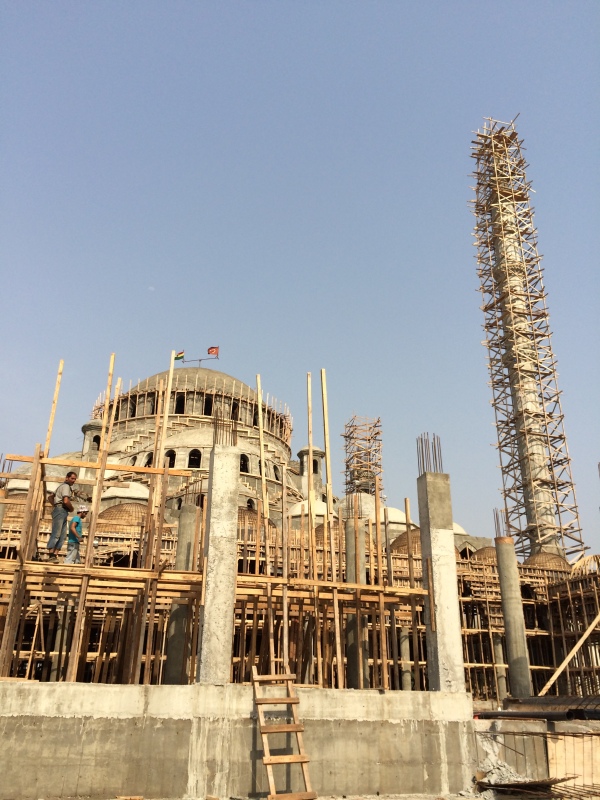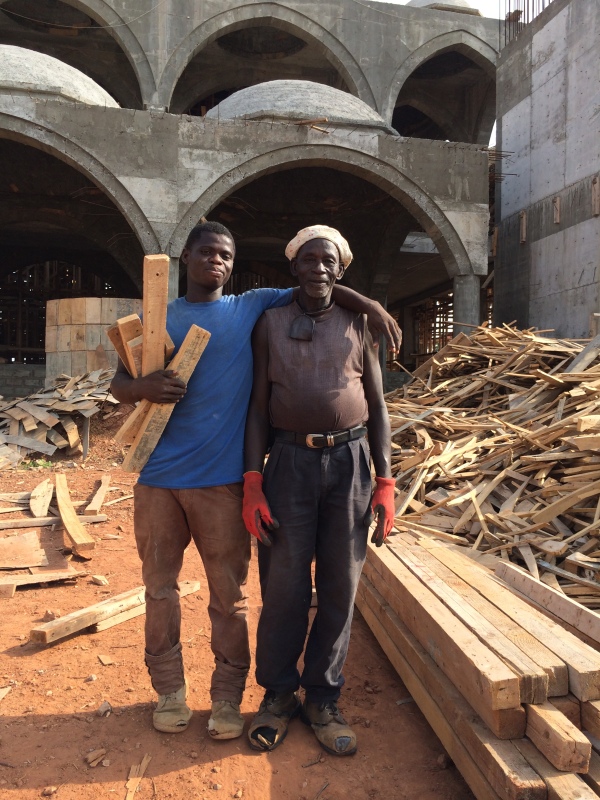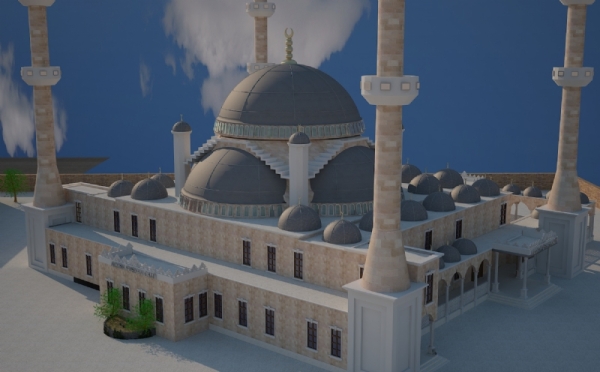Though it’s still under construction, one cannot help but be impressed by the mosque on the Kanda highway. It is a beautiful example of Ottoman architecture, and the arches and perfectly formed domes, in spite of the forest of wooden formwork, give hints of the elegance that is associated with Islamic architecture.
The Accra Furqan, also the Ghana National Mosque, is a gift from the people of Turkey to the people of Ghana, and with its impressive series of domes and semi domes, it has the potential to be one of the most beautiful buildings in the city.
See the flag of Turkey up there?, and those are some of the skillful workers. So many domes!
Constructed with 4000 cubic metres of concrete and 700 tonnes of steel, the Accra Furkan is far from solid or compact. True to the Ottoman architectural style, the domes seem almost weightless, and combined with a clever mix of courtyard spaces and arched walkways, the building manages to appear huge and yet “light”.
Erdiogan Getinkaya’s design is influenced by the Blue Mosque (or the Sultan Ahmet Mosque) in Istanbul as well as the Selimiye Mosque. The 8000 capacity mosque is scheduled for completion in late November, just in time for Ramadan Prayers.
I made some friends 🙂 They’re the 2 of 3 Ghanaian workers there. The project has an unbelievably small workforce!
There are 50 domes in the Accra Furqan building, the largest and main dome sits at a height of 36 metres from the ground and is supported by 4 2.1metre diameter columns at 20 metre intervals. At each of the four corners of the mosque building is one 62 metre high minaret where the “muezzins” will perform “adhans”. The exterior of the building will be finished in polished marble, with the domes cladded in lead.
The facility as a whole will contain a school, health facility and a home for the National Chief Imam.
Architect’s Rendering , not even half as beautiful as the mosque under construction





Reblogged this on Speak Ghana.
Ahhh.. thanks for sharing. Solid info, felt like I was watching some episode of MegaStructures. 🙂
I see it each time I pass by the area. Good info to have. Interesting how Moslems can have a national mosque whiles Christians don’t have one. Perhaps this shows more homogeneity amongst the Moslems? #JustThinkingAloud
Helal olsun. Harika bir hizmet.
Dear Lady
I read your article, thank you for your interest. We have made the structure is a beautiful blend of Ottoman architecture. I’m sending you the finished mosque.
I wish you success in your work.
Erdogan ÇETİNKAYA
Architect
http://imgur.com/a/5E9d3#0
As a Ghanaian Muslim, I’m torn by this.. Although on one hand its great that Ghana gets a large National Mosque to support prayers like those on Eid, and shows the exemplary peace of inter-religious tolerance that truly sets Ghana apart from its squabbling neighbours, I DON’T like the design of it at all, and I’ll explain why:
In northern Ghana and indeed all of West Africa, the nature of Islamisation between the 9th and 15th centuries wasn’t imposed by foreign colonising forces or armies, it was done via African traders from neighbouring tribes and kingdoms, such as the Mali Empire and Hausa Kano, and so you’ll notice that the clothing (agbadas and boubous), food (groundnuts, koose, jollof rice, suya etc) and architecture associated with Muslims in West Africa is that of purely indigenous design and ingenuity.
The oldest Mosque in Ghana, the 14th century Larabanga Mosque (google it for photos, many tourists visit it) is WORLD-RENOWNED by architects and historians as a fine example of the West African “Sudano-Sahelian architectural style” (“Sudano” here refers to the large savanna lands, and not the modern country of Sudan). Along with other Northern Ghanaian surviving medieval architectural masterpieces like the Nakore Mosque, the Bole Mosque etc.. and of course the amazingly impressive and huge 13th century Djenné mosque in Mali that spearheaded it all (it is used as the universal standard of the architectural style). Tourists, architects and academic elites from both the Western world visit West Africa today to document and study these big, very proudly African and atypically designed mosques, built from earth-bricks, local wood and adobe plaster, like the houses around them.
So, noting that very noble heritage, its a complete SLAP IN THE FACE of Ghanaian Muslims that this National Mosque should be nothing more than a cheap concrete imitation of an Ottoman building!! It will jar with every building surrounding it, and put out the false image that Islam is a Middle Eastern cultural thing, as opposed to being a universal religion like Christianity is already accepted to be; and a religion with an old history in Ghana and West Africa. The Ottoman Empire had no territory in Ghana nor was responsible for Ghanaian Islam, and so this building seems a symbol of Neo-Imperialism and Turkish foreign politics to me.
If we were to build a National Mosque FOR GHANA, surely it should be built in, or inspired by the architecturally praised Sudano-Sahelian style OF GHANA. Designed by Ghanaian or other African architects, or maybe culturally sympathetic Western/Eastern architects, it should be made with full use of local knowledge, yet apply modern building tools and materials to bring it into the 21st century. Building something like that would show a sense of pride in Ghanaian and African ingenuity, and would easily be used as a means to unify all Ghanaians regardless of religion, tribe, wealth or ethnicity. A National Mosque designed like that would be a symbol of something to call our very own. Instead, Muslims in Ghana will have to pray in, and be told to be proud of, something that doesn’t really represent us at all.
Thank you for this, Hankali. I myself wondered why it wasn’t designed in that Sudano-Sahelian mould. It reminds me of how upset I was when the Ghana Presidential Palace (Flagstaff House) was designed with Indian support and influences.
Alas, if someone gifts you a building, you can’t really tell them how they must design it.
Please leave out the ethno-centric attitude on this matter. A place of worship need not be built on anyone’s cultural preference. When my great great Grandfather arrived on the Accra, in the mid 19th century, there was not a single mosque around. But yet he prayed facing the AL QUIBLA WITH HIS SWORD AS A BARRIER IN FRONT OF HIM. Later temporal places were made in the form a rectangle. Need iI go on? every Muslim knows it is not the type of mosque you pray in that will make one’s supplication be accepted. But what comes out of your intentions and doing it the way it should be done. AFTER ALL THE WHOLE EARTH IS A MOSQUE AIN’NT IT
Am in Turkey, Istanbul to be precise right now and i must say i am so impressed with the kind of Ottoman-ship Architectural Telepathy being displayed. This mosque when done can be comparable to any of the wonderFUL mASJIDS of the world. i hope this wonderful EDIFICE has no Co-equal in Ghana
like how much money did they use for the construction of kanda mosque?
Be a realist. He who pays the bill has more saying in the final product. The turks paid for the mosque through their foreign aid assistance development to Ghana, as a result, they want the mosque to be a symbol of Ghana-Turkish economic, cultural, political cooperation. There is nothing wrong about the architecture. If you want your own design, you should pay for it.